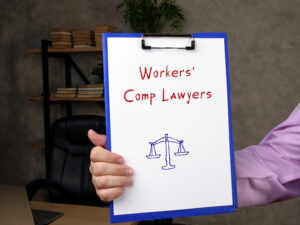Chemical Burn Injuries on a Construction Site
Chemical Burn Injuries on a Construction Site
 If you or a loved one has suffered a chemical burn injury while working on a construction site, it’s now time to understand your legal rights and options for seeking compensation. Chemical burns can cause severe pain, scarring, disfigurement, and long-term health complications.
If you or a loved one has suffered a chemical burn injury while working on a construction site, it’s now time to understand your legal rights and options for seeking compensation. Chemical burns can cause severe pain, scarring, disfigurement, and long-term health complications.
In many cases, these injuries are caused by the negligence of employers, product manufacturers, or other third parties. An experienced Santa Ana workers’ compensation lawyer can file your claim and pursue the full benefits and damages you are owed.
Schedule a Free Initial Consultation Today!
What Are Chemical Burns?
Chemical burns occur when the skin or eyes come into contact with a harmful substance, such as a strong acid or base, oxidizer, or corrosive chemical. On construction sites, workers may be exposed to a wide range of dangerous chemicals, including:
- Cement and concrete mixtures
- Cleaning products and solvents
- Paints, sealants, and adhesives
- Battery acid
- Gasoline and other fuels
- Pesticides and herbicides
The severity of a chemical burn depends on several factors, including the type and concentration of the substance, the duration of exposure, and the area of the body affected. Chemical burns can vary in severity, though you should seek medical attention for:
- Partial-thickness burns: These burns damage both the outer and underlying layers of skin. Symptoms include intense pain, redness, swelling, and blistering. These chemical burns may take several weeks to heal.
- Full-thickness burns: The most serious type of burn is full-thickness burns, which destroy both layers of skin and may damage underlying tissues, such as muscles, tendons, and bones. The burned area may appear white, black, brown, leathery, or waxy. These chemical burns cause severe scarring and usually require skin grafts and extensive medical treatment.
Chemical burns can also damage the eyes, causing vision loss or blindness. If a chemical splashes into the eyes, flush them with water immediately and seek emergency medical care.
Common Causes of Chemical Burns on Construction Sites
Chemical burn injuries on construction sites are often the result of unsafe working conditions, inadequate safety training, or defective products. Some of the most common causes include:

- Improper storage or labeling of chemicals: Construction companies are responsible for ensuring that all hazardous substances are properly stored, labeled, and handled. If chemicals are left in unmarked containers or stored in a way that increases the risk of spills or leaks, workers are more likely to suffer accidental exposures.
- Lack of personal protective equipment (PPE): Employers must provide workers with appropriate PPE, such as gloves, goggles, face shields, and protective clothing when working with dangerous chemicals. Failing to supply adequate PPE leaves workers vulnerable to chemical burns and other injuries.
- Insufficient ventilation: Many construction chemicals release harmful vapors or fumes that can irritate the skin, eyes, and respiratory system. Without proper ventilation, these substances can quickly build up to dangerous levels, increasing the risk of chemical burns and other health problems.
- Defective or malfunctioning equipment: Chemical exposure may occur if pipes, valves, storage tanks, or other equipment fail or leak due to design flaws, manufacturing defects, or improper maintenance. In these cases, the equipment manufacturer or maintenance provider may be held liable for resulting injuries.
- Pressure to work quickly: Construction workers are often pressured to complete projects on tight deadlines. This can lead to rushed or careless behavior when handling chemicals, increasing the likelihood of spills, splashes, and other accidents.
Workers’ Compensation for Chemical Burns
In most states, employers must carry workers’ compensation insurance to cover employees who suffered an injury on the job. If you suffered a chemical burn while working on a construction site, you are likely entitled to workers’ comp benefits, regardless of who was at fault for the accident.
These benefits may include:

- Medical expenses: Workers’ compensation should cover all reasonable and necessary medical treatment related to your chemical burn injury, including emergency care, hospitalization, surgeries, medications, and rehabilitation.
- Lost income: If your injury prevents you from working while you recover, you can receive temporary disability payments to replace some of your lost income. The amount and duration of these payments vary by state.
- Permanent disability: If a chemical burn causes lasting impairments that affect your ability to work, you may be eligible for permanent disability benefits. These are typically calculated based on the severity of your impairment and its impact on your future earning capacity.
- Vocational rehabilitation: Some workers may require training for a new occupation if their chemical burn prevents them from returning to their previous job. Workers’ comp may cover the cost of vocational rehabilitation services in these cases.
- Death benefits: If a worker dies due to a chemical burn injury, their surviving spouse and dependent children can receive death benefits through workers’ compensation.
To file a workers’ compensation claim, you must report your injury to your employer within the deadline set by your state, often 30 days or less. Your employer should then provide you with the necessary forms and instructions to complete the claims process.
While workers’ compensation is designed to be a streamlined, no-fault system, employers and insurers often look for ways to minimize or deny valid claims. They may argue that your injury is not work-related, that you failed to follow safety protocols, or that your condition is not as severe as you claim.
A knowledgeable workers’ compensation attorney can gather evidence to support your claim, appeal a denial or unfair settlement offer, and fight for the maximum benefits available.
Third-Party Liability for Chemical Burns
Although workers’ compensation laws generally prevent employees from suing their employers for job-related injuries, there are some situations where a third party may be held liable for a chemical burn on a construction site.
Examples of potential third-party claims include:
Product Liability
If a defective or unreasonably dangerous chemical product caused your burn injury, you may have grounds for a product liability lawsuit against the manufacturer, distributor, or seller. This can apply to products like cleaning solvents, paints, sealants, or fuels that lacked proper warnings or had design or manufacturing flaws that made them more hazardous than necessary.
Contractor or Subcontractor Negligence
Many construction projects involve multiple contractors and subcontractors working on the same site. If a worker from another company acted negligently and caused your chemical burn, you may be able to sue that contractor for damages. For instance, if a subcontractor’s employee spills a hazardous chemical and fails to clean it up or warn others, leading to your injury, the subcontractor can be held responsible.
Property Owner Liability
Under certain circumstances, the owner of the construction site may be liable for chemical burn injuries that occur on their property. This is more likely if the owner was actively involved in the construction project or knew about a dangerous condition on the site and failed to address it or warn workers.
Equipment Manufacturer Liability
If a defective piece of equipment, such as a malfunctioning valve or storage tank, caused a chemical leak or spill that led to your burn injury, you may have a claim against the equipment manufacturer.
One advantage of third-party lawsuits is that, unlike workers’ compensation claims, they allow you to seek a broader range of damages, including compensation for pain and suffering, emotional distress, and, in some cases, punitive damages meant to punish especially egregious conduct. However, these cases require you to prove that the third party was negligent or at fault for your injuries, which can be more challenging than obtaining workers’ comp benefits.
An experienced construction accident attorney can review the details of your case and advise you on whether you may have a viable third-party claim in addition to your workers’ compensation claim. They can also handle communication and negotiations with the at-fault party’s insurer and fight for full and fair compensation on your behalf.
The Role of OSHA in Chemical Burn Prevention
The Occupational Safety and Health Administration (OSHA) sets and enforces safety standards for the construction industry, including regulations related to hazardous chemicals. Employers must comply with these standards to minimize the risk of chemical burns and other injuries on construction sites.
Some key OSHA requirements include:
- Hazard Communication Standard (HCS): Under the HCS, employers must inform workers about the hazardous chemicals present in their workplace. This includes maintaining safety data sheets (SDSs) for each chemical, labeling containers appropriately, and providing training on the potential health effects of the substances and how to handle them safely.
- Personal Protective Equipment (PPE): OSHA mandates that employers assess the hazards in their workplace and provide workers with appropriate PPE to protect against chemical exposures. Depending on the specific chemicals being used, this may include gloves, goggles, face shields, aprons, or protective suits.
- Permissible Exposure Limits (PELs): OSHA sets permissible exposure limits for many hazardous chemicals, which are the maximum amounts of a substance that workers can be exposed to over a specified time period without experiencing adverse health effects. Employers must monitor exposure levels and take steps to keep them below the PELs.
- Ventilation: Construction companies must provide adequate ventilation in areas where hazardous chemicals are used to prevent the buildup of harmful vapors or fumes.
- Emergency eyewash and shower stations: If workers are exposed to corrosive chemicals, employers must provide readily accessible eyewash and shower stations for immediate treatment.
If OSHA finds that an employer has violated these or other safety regulations, they may issue citations and fines. In some cases, evidence of OSHA violations can also be used to support a workers’ compensation claim or third-party lawsuit by demonstrating that the employer or another party failed to maintain a safe work environment.
Pursuing Compensation with a Workers’ Comp Lawyer

Dealing with the aftermath of a chemical burn injury on a construction site can be overwhelming. In addition to coping with pain, medical treatments, and time away from work, you may face resistance from your employer or their insurance company when seeking the benefits you deserve. A skilled workers’ comp lawyer can be your advocate throughout the claims process, working to protect your rights and maximize your compensation.
Some of the ways a lawyer can assist with your chemical burn claim include:
- Gathering evidence: Your attorney can collect medical records, accident reports, witness statements, and other documentation to support your claim and establish the severity of your injuries.
- Navigating the claims process: Workers’ compensation laws and procedures vary by state and can be confusing. A lawyer can ensure you meet all deadlines, complete the necessary forms, and provide the information required to advance your claim.
- Communicating with the insurer: Insurance companies often try to limit payouts by disputing the extent of a worker’s injuries or pushing for a quick, lowball settlement. Your lawyer can handle all communication with the insurer, advocating for your interests and working to negotiate a fair resolution.
- Appealing denied claims: If your workers’ comp claim is denied or you are awarded insufficient benefits, a lawyer can file an appeal and represent you at hearings before an administrative law judge.
- Exploring third-party claims: An experienced attorney can review your case to determine whether you may have grounds for a third-party lawsuit in addition to your workers’ compensation claim. If so, they can pursue damages from all responsible parties.
No one should have to face the challenges of a serious chemical burn injury alone. If you have been harmed by hazardous substances on a construction site, contact a workers’ compensation attorney today for a free consultation. With their knowledge and advocacy on your side, you can focus on your recovery while they fight for the full compensation you need to move forward.
Contact a Skilled Workers’ Comp Lawyer Today
Chemical burn injuries on construction sites can have devastating consequences for workers and their families. These painful and often disfiguring injuries may require extensive medical treatment, cause long-term disabilities, and lead to significant financial hardship. If you or someone you love has suffered a chemical burn on the job, it is important to understand your rights and options for seeking compensation.
Working with an experienced workers’ compensation attorney ensures that you will pursue the full benefits and damages you are entitled to under the law. Your lawyer can guide you through the claims process, gather evidence to support your case, negotiate with insurers, and explore any potential third-party claims.
Don’t wait to get the legal help you need after a serious workplace injury. Contact a skilled workers’ comp lawyer today to schedule a free consultation and take the first step toward protecting your health, financial security, and future.


